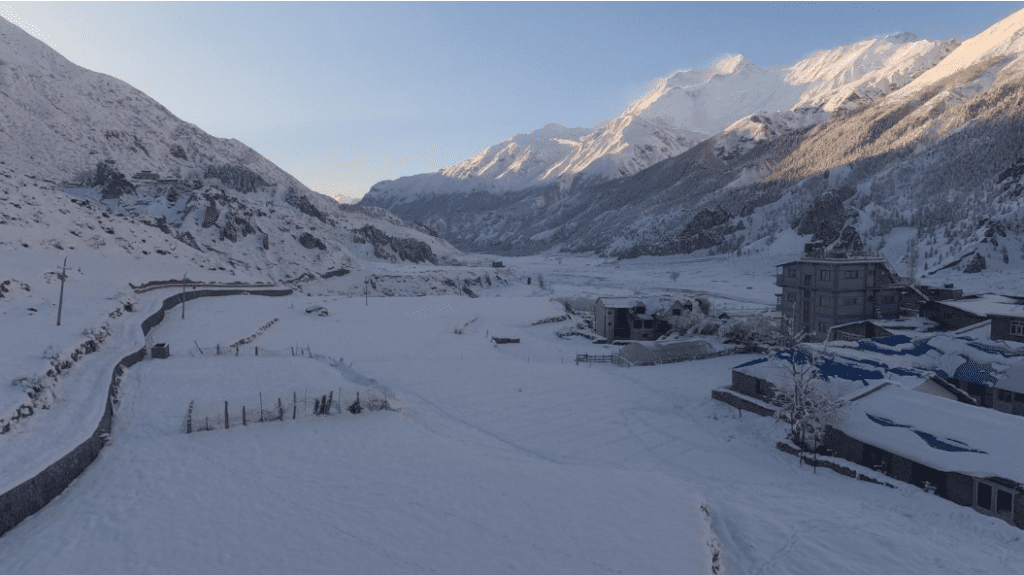
Given the thousands of trekkers who visit the Circuit annually and are captivated by the region’s allure, Annapurna Circuit is the primary focus. The wild is the primary draw of the Circuit, rated as one of the finest wilds in the world and the only one in the Annapurna Conservation Area. You will be able to see Himalayan fauna from a safe and nonthreatening distance in their undisguised environment.
Furthermore, you will be able to visit Manang Village, Thorong-La Pass and Muktinath Temple before your journey is complete. All of these characteristics make it a full and unique bundle.
The Annapurna Circuit Trek is not a piece of cake, rather it is a journey that will stretch your physical boundaries and push beyond the limits of your mental stamina. The scene alters as you climb up from luscious subtropical jungles to arid deserts and alpine grasslands. One feature of the Annapurna region is its variety of challenges that can test your endurance and determination. It is such an achievement which will give you more than just fulfillment when you hit the top most point, 5400 meters at Thorang-La Pass.
Further, Annapurna circuit trek is an adventurous tour filled with awe-inspiring natural wonders. On top of all these, local communities are lively while their cultures are also vibrant. These people can provide you with insights into how they live their lives and what heritage they safeguard in the area. Consequently, you gain a deep respect for traditions which have lasted for hundreds of years.
Table of Contents
- 1 Key moments from the Annapurna Circuit Trek
- 2 How to prepare yourself for the Annapurna Circuit
- 2.1 Physical Fitness and Training:
- 2.2 Travel documents and permits
- 2.3 Health and Safety
- 2.4 Route and Itinerary planning
- 2.5 Nutrition and hydration
- 2.6 Electricity and electrical ports during the trek
- 2.7 Money during the trek
- 2.8 Accommodation during the trek
- 2.9 Best time for the Annapurna Circuit Trek
- 2.10 Travel responsibly
- 3 Pros and Cons that you should know about
- 4 Packing List for the Annapurna Circuit Trek
Key moments from the Annapurna Circuit Trek
Same as you, the Annapurna circuit is a must-visit place to trekkers around the globe. It has a start through one of Nepal’s largest conservation areas, the Annapurna Conservation Area. The trek offers a glimpse of the Kali Gandaki Gorge, one of the worlds’ deepest gorges. In spring, the colorful rhododendron woods in the low region burst vibrantly. Villages like Pisang, Chame, and Manang provide an exceptional view of Annapurna II and IV. Additionally, Braga, which hosts a 500-year-old monastery represents a beautiful touch of Tibetan culture.
Pass through the culturally significant town of Jomsom, the Windy Valley. It is the gateway village to the desert-like terrain of the Upper Mustang area, renowned for its intact Buddhist culture through the centuries. Another is passing through the Thorang-La Pass at an altitudinal height of 5416 meters, one of the highest passes on this trek. Besides, visiting the holy Muktinath Temple is an additional spiritual adventure.
Walk through the villages of Manang and Marpha; unique architectural designs with the locals’ warmth offer an exquisite experience. The mesmerizing environment, cultural richness, and physical wellness will place the Annapurna Circuit Trek top on the list of a majority of short-time adventurers.
How to prepare yourself for the Annapurna Circuit
Physical Fitness and Training:
Engage in such physical activities as run, cycle, swim or go to the gym. Concentrate on your legs, stomach and spinal muscles with exercises like squats, lunges and deadlifts. You can also hike at your local hiking spots to help you get used to walking for long distance.
Travel documents and permits
Your passport should be valid for at least six months beyond your Nepalese visa’s expiration date. Before you visit Nepal obtain your TIMS (Trekker Information Management System) and Annapurna Conservation Area Permit (ACAP).
Health and Safety
Make sure that you are immunized especially against which vaccinations are necessary when going to Nepal. Do not forget to pack any needed personal medications that should be taken daily by you Also, ensure that you possess a comprehensive travel insurance policy which covers emergency evacuation, high altitude rescue and hospital expenses.
Route and Itinerary planning
Make yourself comfortable with the standard Annapurna Circuit route through Dharapani, Chame, Pisang, Manang, Thorang Phedi,Muktinath, and Jomsom. If you would like an alternative experience, look up the Tilicho Lake trekking option online.
Nutrition and hydration
Energy Bars, nuts, dried fruits, energy drinks are some examples of high-energy snacks that should be carried as you embark on your journey. Drinking can be done either from the spring and also using a water purifying tablet or filter or by buying bottled water. Local lodges or tea houses will have to cater for your meals. However, you need to inform them about any allergies as well as special dietary requirements such as gluten-free.
Electricity and electrical ports during the trek
Electricity is available in almost every lodge and guesthouse. This usually comes at a charging station located in these facilities but at different prices depending on the place where it is being offered. In Nepal, two- and three-round pin plugs are used. The average voltage output is approximately 220 to 240 volts while the frequency stands at 50 Hz. You can buy a universal adapter that suits all your needs.
Money during the trek
When you arrive at the airport or near your hotel, you can get cash or exchange money here if needed. It is advised that you bring some cash along for personal expenses while trekking; About NPR 3000 per day would suffice as pocket money during your stay there/ An ATM in Nepal typically has a withdrawal limit of NPR 30,000 to NPR 50,000 only.
Accommodation during the trek
As you go on a hike, you will find homes of all kinds along your way and they are typically family owned establishments. In most cases these are homestays. Such units have either squat or western toilet facilities depending on their type. They are however, equipped with all necessary facilities such as attached toilets and comfortable beds in most places. A sleeping bag is essential for your travel kit. There may be a wood fire in the dining/kitchen area to keep cold at bay.
Best time for the Annapurna Circuit Trek
The Annapurna Circuit Trek takes place almost throughout the year but the best times to trek it are spring (March, April and May) and autumn (September, October and November). At such moments you can also catch site of Mount Annapurna picture-perfectly while enjoying clear skies and breath-taking panoramas. The summer period can also be taken into account for this kind of journey across mountains. This is when green vegetation is everywhere with wildflowers blossoming in their natural state; hence it would be perfect for you if seeing all this sounds attractive to you. Mild day-time temperatures characterize this season which makes it ideal for hiking.
Travel responsibly
We aim to arrange eco-friendly trips that uplift small communities by boosting local entrepreneurship through support provided by our trekkers towards their enterprises so as they can get more customers who eventually become committed clients thus helping us achieve our desired objectives of community growth and development .
Pros and Cons that you should know about
Pros:
- Stunning scenery: The Annapurna circuit trek becomes home to the Himalayas’ breathtaking, including the massive Annapurna, Dhaulagiri, and Manasalu.
- Cultural experience: This Annapurna circuit path passes near the world’s largest Gurung settlement, offering many trekkers a chance to see the local culture and traditions.
- A sense of achievement: Many trekkers crowd the Thorang-La Pass at an altitude of 5,416 meters, which gives off a sense of triumph and accomplishment.
- Physical fitness: These circuit treks are physically demanding, with a strong emphasis on cardiovascular fitness and endurance.
Cons:
- Crowded Trails: This route is trendy worldwide, which can make it crowded during the peak season.
- Altitude sickness: This trek’s high altitude presents a risk of Acute Mountain Sickness (AMS), which can cause headaches, nausea, and more severe conditions.
- Cost: The Annapurna Circuit Trek can be expensive, considering the permits, guide fees, equipment, meals, accommodations, and flight tickets.
- Physical Strain: This Annapurna journey can be physically straining and require good fitness and preparation.
Packing List for the Annapurna Circuit Trek
Clothing
- Thermal tops and bottoms
- Fleece jackets or insulated jacket
- Waterproof and Windproof Jacket and Pants
- Convertible pants for Trekking
- Caps or Hats
- Insulated gloves
- Neck warmers
Footwear
- Waterproof and sturdy hiking boots
- Woolen or synthetic socks
- Gaiters
Accessories
- Day carrying backpacks with rain covers
- Four-season sleeping bags
- Adjustable trekking poles
- Headlamps with extra batteries
- UV Protecting sunglasses
Toiletries and medications
- Personal Hygiene items
- Sunscreen and lip balm
- Personal medications
Electronics and miscellaneous
- Personal camera
- Power pack or Power bank
- Up-to-date travel documents
- Trekking guidebooks and maps
Conquering the Annapurna Circuit is a moment to reflect on your great accomplishment. This trip is marked by mesmerizing landscapes, challenging terrains, and cultural significance, which offers trekkers a sense of achievement and self-confidence. Completing the circuit is a testimony of the traveler’s perseverance and determination.
The explorers have stunning views of the mountains, valleys, and charming villages throughout the trek. The warmness of the locals and the spirituality of the ancient monasteries further enhance this experience, which combines to create a memorable adventure.
